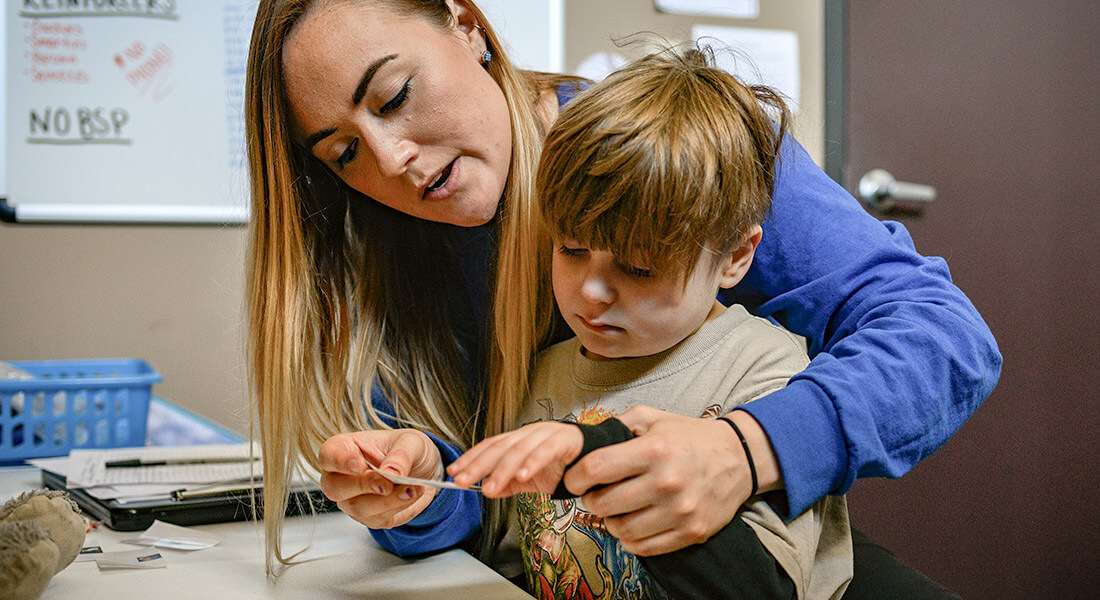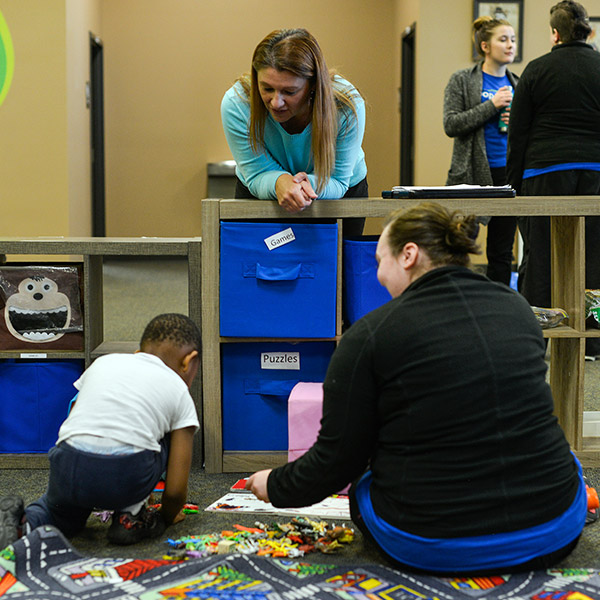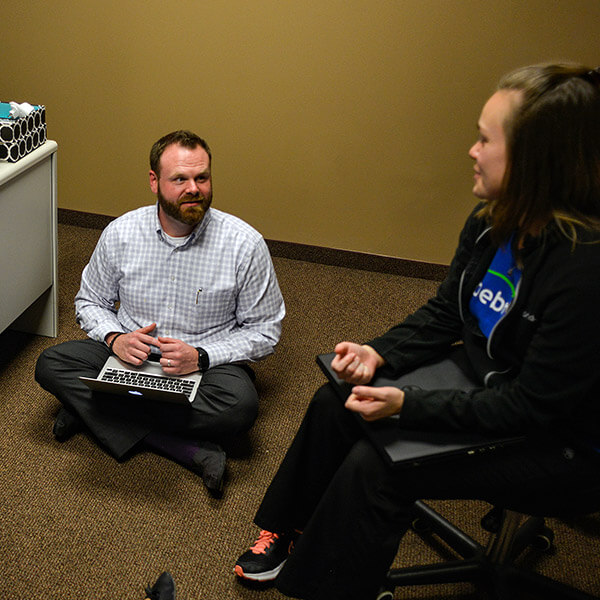Will My Child Be in ABA Therapy Forever? Learn from a Hopebridge BCBA
December 15, 2018
December 15, 2018

If you parent a child diagnosed with autism spectrum disorder (ASD), you know all about the word, “forever.”
“Will he have these autism symptoms forever?”
“Will she have to live with me forever?”
“Will my child need ABA therapy forever?”
The answers to these questions are not usually a simple ‘yes’ or ‘no,’ so we like to turn to our knowledgeable and experienced Board Certified Behavior Analysts (BCBA) to provide some insight. As part of our blog’s education series, Hopebridge Merrillville Clinic Manager and BCBA Jessica Schumacher of Indiana discusses the goals of applied behavior analysis (ABA therapy) and whether individuals need it for life.
A parent once said to me, “I just want to know when this dark tunnel ends and if the light at the end is the sun or a train.”
I told her, “I may not be able to show you the light at the end of the tunnel right now, but I can give you a flashlight.”
As a center manager, I have had conversations like this over and over and I understand the concern. Through our work, we are asking for a lot of trust and time from caregivers and it takes a lot of courage and patience on their end.
If you go to the dark depths of Google – which I do not recommend! – ABA can get a bad reputation and we’ve had to overcome a lot of misconceptions. One is that we “take your kids and never give them back.” This could not be farther from the truth. While we love them dearly and never want to say goodbye, some of the best days are when they graduate out of the program because it means we have done our jobs and this child has new opportunities ahead.
So what is the measurement of days, months, years? Everyone wants to know, but unfortunately there’s not a quick answer. I can’t give you an official timeline of therapy for your child, but I can tell you it’s not forever.
Within ABA therapy, we do not focus on a timeline; we focus on goals. The purpose of ABA is to develop an individual’s skills so he or she is able to function in real-life situations in an appropriate and healthy manner. If you think about how long a child has been working on certain goals before they came to us, as well as how long they had engaged in certain behaviors, you can understand why each timeline is different. Maladaptive behaviors that have become habit, for instance, may take more time and more intensive interventions in order to replace those with more appropriate behaviors.

Within ABA therapy at Hopebridge, we do not focus on a timeline; we focus on goals.
To set and facilitate these goals, we look at what is needed to enable them to function in their most natural setting. Not only do our kiddos vary, but their natural settings vary as well, and a lot of it can depend on age. Long-term goal transitions could be daycare or school. There is a big difference between preschool and third grade, so we might break these down even further. For instance, within a school, we could be looking at one-on-one aids, supports in general education or special education classrooms. For others, the transition might be home or residential care.
Before we ever transition, we focus on three different areas:
As the learner gains independence and catches up on age-appropriate behaviors, he or she is likely nearing transition. If they would be working on the same types of goals in school, then it might be time to move to the natural environment. We are here to get these kids caught up and once they reach that point, we want to make sure they have the tools for a safe and smooth transition.
Once this occurs, we look at where they are and where they are headed in order to make adjustments. If they are full time – approximately seven to eight hours a day, five days a week – then we can collaborate with parents and schools to set up a part-time schedule of half-days or a few days a week.

The timeline on when we create new goals and transition is all piloted by progress.
Once a child is part-time ready to transition out of ABA therapy entirely, we will plan to meet with parents. We still want to be a resource to see how they are doing and step in to help if something changes. We can collaborate with the school, provide feedback, troubleshoot and even have them come back, if needed.
The timeline on when we create new goals and transition is all piloted by progress. Some children will progress with different timelines than others and require different types of progress. The good thing is, if you need a lot of time, we have a lot of time to give. If you don’t, then we’re not going to keep you forever either! Everyone works at a different rate, and that’s why we choose ABA therapy – everything is individualized.
We are not doing this on our own – we want to work with you!
One of the biggest drivers of success is attendance. Consistency is key, so if your child is here with us as often as recommended, you are already doing a huge service. When we have a family dedicated to sticking to the schedule and committing to an intense intervention, we do not take it light-heartedly. We take that trust and do whatever we can to show you progress.

We are not doing this on our own – we want to work with you!
I also always encourage caregivers to be open and honest about goals, expectations, what is working and what is not. I can give what I think is the Mona Lisa of support plans, but if it does not work for you – whether that means time or physical constraints or it is just not appropriate in your home setting – I can come up with a different plan. This is important because if it will not work in a natural setting, then it will not work for that child. We are never going to throw our hands in the air and give up; we are constantly looking for the next resource and plan to maximize the potential for your child.
It does not go unnoticed from a BCBA or those in my role that families put their trust in us. I know they want answers and to learn how fast we can prepare a child for a functional life. We want them to succeed and graduate from services as much as you do, but it is a process. It can be daunting – it is not a one-hour-per-week treatment. It is a commitment, but one in which we all dedicate ourselves in order to experience progress.
While ABA therapy does not mean forever, the tools and strategies we use during our sessions can last a lifetime. If you’re interested in learning more about ABA therapy at Hopebridge, please get in touch with us online to find a center near you.
*Informed consent was obtained from the participants in this article. This information should not be captured and reused without express permission from Hopebridge, LLC. Testimonials are solicited as part of an open casting call process for testimonials from former client caregivers. Hopebridge does not permit clinical employees to solicit or use testimonials about therapeutic services received from current clients (Ethics Code for Behavior Analysts 5.07-5.08; BACB, 2020). Hopebridge does not provide any incentives, compensation, or renumeration for testimonials provided by a former client or client caregiver.
Parenting Resources
October 29, 2024
A Guide to Understanding an Autism Diagnosis and Documentation
Hopebridge in the News
June 18, 2019
Hopebridge Autism Therapy Centers Expand Into Fishers and Columbus, Indiana
Parenting Resources
September 08, 2021
Three Personalized Grandparents’ Day Crafts for Kids with Autism
Parenting Resources
December 08, 2024
A Caregiver’s Perspective: What to Expect from ABA Therapy